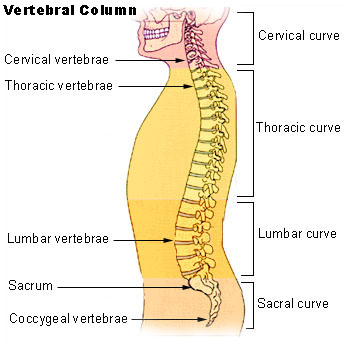Occupational Biomechanics
Occupational Biomechanics
- The use of mechanics methods, principles, and ideas to study biological systems
- A science concerned with the mechanical behavior of the musculo-skeletal system and component tissues when physical work is performed
Definiton
Importance
Basic Biomechanics
Examples
Lower Back Pain is a major problem in working environments
- Common in nurses
- Older workers - musculo-skeletal system
- Occupational, Sports, Military Biomechanics
Overall
More injuries with more muscle exertion
- Older the age, the more chance of spraining or hurting something
- Overexertion is cited as the most frequent and costly claim (lower back)
- Absenteeism, leads to high workers compensation
Newton's Laws: Static Equilibrium Conditions
- Sum of Forces = 0
- Sum of Moments = 0
Lower Back Biomechanics

Spinal Cord
- Cervical - neck section, 7 disks
- Thoracic - chest section, 12 disks
- Lumbar - back section, 5 disks
- Sacrum - hip portion, fused
L5/S1
5th lumbar disc and 1st sacrum disc
Lower Back Pain
Back pain usually refers to long term disc pain (Generally in L5/S1
- Two bones (L5/S1) have tissue in between and a nerve in the back. When bones are moved, tissue can hit the nerve and it causes stinging pain.
Moment
Created by weight and distance
- The force on the L5/S1 is roughly 10-15 times greater than the force of the load being lifted
L5/S1 is furthest point from movement
- There is the most torque/rotational movement
- Since it is furthest point away, largest moment is caused
Back muscles do the lifting and Rotating
- Small distance from axis of rotation
- Small distance to deal with large object
Skeletal System Facts
- Upper body is more than half of the body weight
- When you lift, you magnify the weight
Compression Forces
- Soft tissue (annulus Fibrosis) will overflow - can't go forward because of abdominal wall so it goes backwards into nerves causing discomfort called L5/S1 Herniation
- Results in spinal nerve compression and inflammation
Most people overestimate their ability to lift things.
- Suitcases in airplanes
- Athletes tend to get hurt more because they think that they are strong enough, correlation relationship not causual
Psychophysical
- Estimate on how much you think you can lift, tends to be overestimated so don't use it conclusively.
Lower Back Pain Causes
Explanations as to how the L5/S1 can get damaged.
3. External Load movements on spine must be kept small to protect the back
- Keep load close
- Keep load off the floor
- Keep torso as vertical as possible
- Do not jerk with fast loads
- Avoid Asymmetric Lifting
Physical
Description
Lower Back Biomechanics
1. The spine needs muscles to move and stabilize against external movements often requires in manual lifting.
Description
2. High muscle forces create high disc compression forces that can (and do) exceed the tolerance of most lumbar spinal disks.
Disk to Disk Injuries
4. Asymmetrical lifting and twisting poses a special risk to the back and should be avoided.
Description
5. Risk of spinal trauma may not be reduced enough by psycho-physical "strength" norms, since resulting tissues forces into lower back may not be sensed until trauma causes inflamation.
Description
Major Types of Back Pain
Description
Soft Tissue
- Muscles
Disc Related Tissue
- Herniation
- Fracture
Useful Equations to Know
- ΣTaround L5/s1=0
-
Mload-to-torso = Wload&body *d
- Where:
Wload&body = upper body weight
d = horizontal distance from the load to L5/S1 disc - Mback-muscle = Fback-muscle X 5 (N-cm)
-
Fcompression = Wload&body X cosα + Fmuscle
Where:
- α = angle between horizontal plane and sacral cutting plane, which is perpendicular to the disc compression force - Fshear = Wload&body X sin α